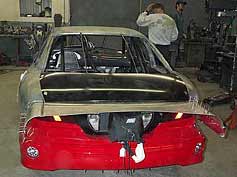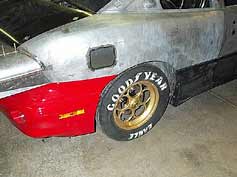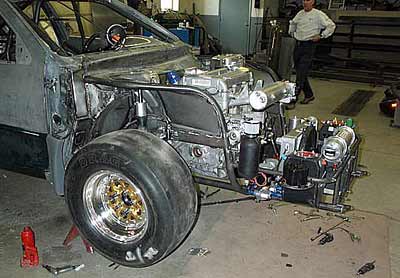|

 |
 |
| Given the speeds these cars
are capable of, an enlarged rear wing is pretty much
mandatory. FYI, this particular car has run (in official
competition), speeds in excess of 166MPH. ET’s
routinely range in the 8.53-8.67-range. That’s
stout four-cylinder stuff in anyone’s books – FWD
or RWD. |
OK. This is where the business
end of the car normally is, but in a FWD combination,
the big tires observably go on the front. At the rear,
light is definitely right – particularly when
you read the Rules and find that a four cylinder car
with two power adders (for example, a turbo and nitrous)
must weigh 2100 pounds minimum. |
The final piece of the chassis
puzzle that you should consider is this: Cars such as our
sample Sunfire Hot Rod class racer are actually tire restricted.
Here’s what the Rulebook
has to say:
Tires: “DOT or racing slicks permitted with maximum
width of 10.5 inches and maximum height of 28 inches. Maximum
rollout on drive tires 88.5 inches.”
 |
| Here’s a look at the
same car as it nears completion. In the text, I mentioned
how traction requirements forced everything forward.
As you can see, there’s hardware aplenty forward
of the engine. This photo also gives you some idea
of the tire packaging requirements. FWD combinations
probably define “dense packaging” from
a drag racing perspective! |
As you can see, there’s a bunch more to these cars
than first meets the eye. With that, we decided to dissect
the “old” 2004 Pontiac Sunfire campaigned by Marty
Ludwig and Bothwell Motorsports. This car was built by Mike
Pustelny Racing in conjunction with General Motors, and by
all accounts was one of the quickest FWD Hot Rods on the planet.
And even if you’re not a fan of FWD racecars, you’ll
probably appreciate the effort that goes into these cars (and
please, don’t shoot the messenger – this writer
has a garage full of '60s and early '70s Novas and parts).
For a closer look, check out the accompanying photos.
|

